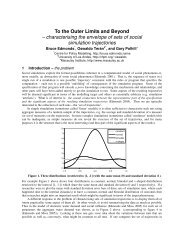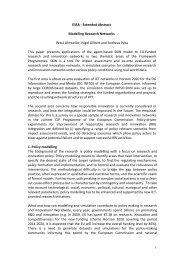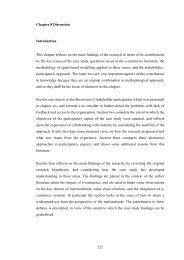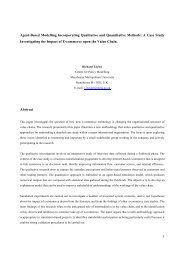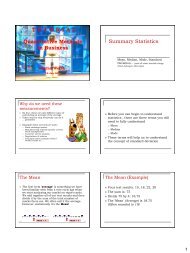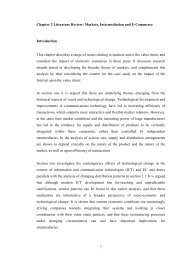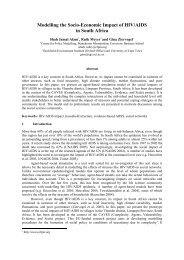3 Chapter 1 Introduction This thesis addresses questions ...
3 Chapter 1 Introduction This thesis addresses questions ...
3 Chapter 1 Introduction This thesis addresses questions ...
You also want an ePaper? Increase the reach of your titles
YUMPU automatically turns print PDFs into web optimized ePapers that Google loves.
<strong>Chapter</strong> 1 <strong>Introduction</strong><br />
<strong>This</strong> <strong>thesis</strong> <strong>addresses</strong> <strong>questions</strong> concerning the impact of Internet-based e-commerce<br />
(EC) upon supplier and customer relations. These <strong>questions</strong> are investigated from an<br />
industry value chain perspective, by means of interpretive management research<br />
combined with agent-based modelling.<br />
Starting from the baseline hypo<strong>thesis</strong> that Agent-Based Social Simulation (ABSS) can<br />
provide insight on the impact of EC upon value chain relations, and upon the<br />
opportunities that exist for intermediation, my specific objectives are, firstly, to<br />
advance the state of the art in multi-agent modelling by incorporating qualitative<br />
aspects into a formal model, and by inviting the input of ‘stakeholder’ experts<br />
working in the industry, and secondly, to inform those stakeholders on the<br />
opportunities and pitfalls of initiating an e-commerce system within their existing<br />
value chain configuration. These objectives will be tested by carrying out a case study<br />
investigation involving interpretation of fieldwork data and analysis of the model to<br />
explore e-commerce scenarios.<br />
In doing so I will argue that (1) an agent-based representation is appropriate to model<br />
the supply chain interactions and engage stakeholders in the processes of formulation<br />
and evaluation of these models, (2) the behaviour this type of model can demonstrate<br />
plausible outcomes and identifiable patterns associated with the system under<br />
investigation, (3) whilst formal models cannot capture the syntactic depth of findings<br />
that emerge through interpretation of qualitative fieldwork, it is nevertheless possible<br />
to qualify simulation data in a satisfactory way, and (4) modelling is valuable when<br />
used in conjunction with qualitative analysis as a complementary method to explore<br />
the research <strong>questions</strong> in a rigorous and formally consistent way.<br />
The roadmap for the <strong>thesis</strong> is as follows: in the literature review of chapter two, the<br />
new technological developments in electronic commerce technology are placed in the<br />
light of the literature on value chains and the economics of markets. <strong>This</strong> discussion<br />
involves historical perspectives of the changing nature of markets and organisations as<br />
well as more contemporary work on transaction costs economics and value chains,<br />
and the impact of socio-technological developments. The chapter then moves on to a<br />
3
discussion of Electronic Data Interchange (EDI), a well established form of e-<br />
commerce, which provides many of the same business advantages, but also similar<br />
problems of adoption and integration. Finally, the remainder of the chapter focuses<br />
upon the role of the intermediary and the development of a potential new marketing<br />
and distribution arrangement, namely direct sales via the Internet channel.<br />
In chapter three, comparing ABSS with other approaches involving formal modelling,<br />
it is argued that this promising new field of modelling offers benefits for research<br />
focusing upon difficult problems involving complex, distributed, interactive systems,<br />
such as the Internet. The chapter provides a grounding in the objectives and<br />
opportunities of agent-based modelling, and reviews some recent work of a high<br />
standard in this field.<br />
<strong>Chapter</strong> four surveys the field of qualitative research methods, with a focus on case<br />
study research carried out in the area of Information Systems. The research<br />
methodology is outlined in section 4.1.4. Drawing upon several different paradigms, it<br />
combines individual methods to integrate the qualitative with the quantitative. It is<br />
argued that flexibility in choice of research methods (i.e. multi-methodology) allows a<br />
richer understanding to develop of complex issues involving technological change.<br />
<strong>This</strong> chapter also provides a preliminary discussion of the case study. As part of a<br />
large multinational based in the UK, the industrial partners manufacture a range of<br />
products to equip factories with Industrial Automation equipment. The market is<br />
exclusively business-to-business, and there is a large number of independent<br />
distributing companies (distributors) throughout the UK who hold inventory and<br />
provide a local service to the many smaller customers. The company also has<br />
thousands of customers who are supplied directly from a central European store.<br />
At the time of the study, the company was undergoing business process reengineering<br />
to integrate existing EDI and telephone/FAX-based communication with Internetbased<br />
e-commerce in a gateway system to interface with their internal systems and<br />
databases. The centrepiece of this transformation was the Internet-based electronic<br />
mall, specifically designed to encourage e-commerce amongst direct customers not<br />
currently using EDI. In addition, the company wanted to bring its distributors onboard<br />
4
with their own electronic systems, hence improving information flow and customer<br />
service throughout the supply chain.<br />
The research objectives and case study design were jointly defined by the author and<br />
the stakeholders over a series of meetings. The research <strong>questions</strong> centred on the<br />
impact of Internet-based e-commerce upon intermediaries’ role and market share,<br />
upon the internal processes, efficiency improvements and resource savings that could<br />
be realised, and the identification of inhibitors and incentives for customer adoption of<br />
the electronic mall. Semi-structured interviews took place with nine employees,<br />
including members of the e-commerce team, order management and internal sales<br />
departments.<br />
These qualitative data were analysed, and the emergent findings of the fieldwork<br />
investigation are presented in chapter five. <strong>This</strong> chapter reveals the respondents’<br />
views on the future direction of the company and opportunities for moving towards a<br />
fully-integrated electronically mediated supply chain. Interview responses were<br />
analysed regarding customer and distributor perceptions of e-commerce: their<br />
concerns and objections as well as their understanding of the benefits. It explores<br />
what the manufacturer expects of its distributors in terms of compliance with e-<br />
commerce systems, and analyses their influence through different strategies for<br />
encouraging adoption.<br />
The aim of chapter six is to link the qualitative findings discussed in chapter five with<br />
the agent-based model of the case study. It discusses how the fieldwork informed the<br />
model specification, and how stakeholder involvement influenced its development.<br />
Section 6.1 describes the interactions between the researcher and the stakeholders, and<br />
how the relationship developed. Stakeholder evaluation involved taking the findings<br />
of the research back into the company and soliciting their expertise. Their contribution<br />
was in terms of clarifying the basis for model assumptions, providing feedback upon<br />
the simulation results, and suggesting improvements to the research design.<br />
<strong>Chapter</strong> seven, section two presents a description of the model, which, it is argued, is<br />
an abstraction of the market system described in the fieldwork of chapter five that<br />
allows exploration of the research issues discussed earlier. Throughout the<br />
5
description, assumptions of the model are noted, and the justification for using them<br />
stated. Section 7.3 presents the results of the simulation experiments with the model.<br />
It is divided into a discussion of four distinct model scenarios, each of which focuses<br />
on a particular aspect of the model to address specific research <strong>questions</strong>. A<br />
sensitivity analysis was also carried out to test the robustness of the results to changes<br />
in program implementation: in the less well-validated model assumptions, and in<br />
several parametric values used.<br />
<strong>Chapter</strong> eight discusses the contribution of the research to knowledge about value<br />
chain issues, to qualitative research methodology, and to agent-based modelling<br />
technique. The success of the project is evaluated both in terms of academic value to<br />
other researchers and in terms of its value to the stakeholders. <strong>This</strong> chapter reflects on<br />
the importance of the stakeholder contribution, its successes and failings, and the<br />
usability of the approach. The lessons learnt from developing the agent-based system<br />
in collaboration with industry are summarised. Finally, a balanced critique of the<br />
work undertaken in this <strong>thesis</strong> is made, and some suggestions for further research are<br />
presented.<br />
6




